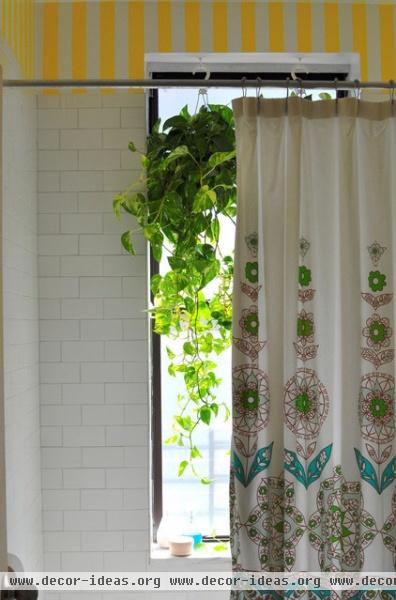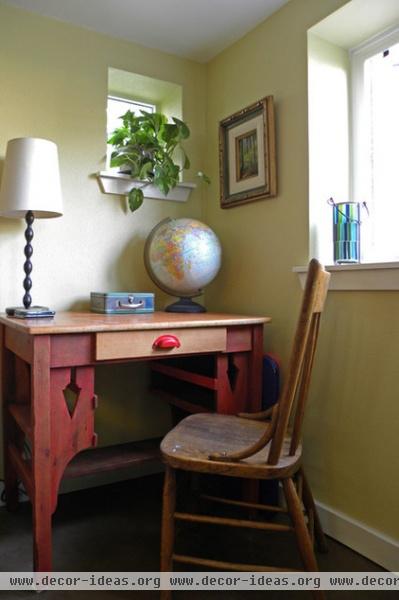The Perfect Houseplant for People Who Kill Houseplants
The bright-green-leaved golden pothos vine is known to be the perfect houseplant for even the blackest of thumbs, as it has a high tolerance for neglect. Lack of water and sunshine? No problem. With the recent emphasis on the benefits of owning houseplants for air purification purposes, pothos receives rave reviews for its special ability to efficiently remove airborne toxins such as carbon monoxide and formaldehyde.
That said, if you're like me, your experience with pothos probably includes seeing it too many times in pizza parlors, at truck stops and possibly growing out of a fish tank. But pothos is actually very versatile, able to adapt to and enhance almost any decor style. Its potential all depends on the environment in which it's placed.

A bathroom with a large window is a great place for just about any plant, but in this scenario, a hanging plant also creates some privacy. A healthy pathos that's both bushy and trailing adds a little bit of jungle to the charming bathroom, while the fun retro-style pattern on the shower curtain works with the simple silhouette of the hanging plant.

Pathos exudes a homey retro feeling; it looks great placed in this small bedroom window as a complement to the rustic desk and vintage globe.
Tip: Placing a trailing plant in a high, awkwardly sited window is a smart use of a space that might otherwise detract from the balance in a room.

Pathos' light green leaves work especially well with wood furnishings. Here a small pathos in an aqua pot adds a welcome touch of green to this eclectic vignette.

A bushy pothos flourishes on a low windowsill niche.
Tip: It's a wise decorating trick to place a nice plant in a spot that might otherwise accumulate junk.

Pothos is just one of the many plants growing in this lush windowsill garden, and the use of blue growing bags, rather than pots, is in tune with the easy style of the space.

A trailing pothos vine placed atop a vintage wardrobe adds a quaint personal touch to this light-filled space.
Tip: If you'd like to enjoy pothos for its vining capabilities, keep a portion of the plant short and bushy to maintain pleasing proportions.

Place your pothos on a high shelf and let it cascade wildly down. Exposed brick, a collection of wine bottles, a book collection and a casually placed guitar complete the look here.

Pathos is great for growing on a tall plant stand, which can give it the impression of a tree. You can achieve this full look by planting several pathos plants together.
How to care for your golden pothos vine:
Light: Most houseplants prefer bright indirect light, though pothos can also live in low-light conditions as well as artificial light, making it the perfect office cubicle plant. Pothos with variegated leaves as opposed to solid green leaves are less tolerant of low light.Water: Water thoroughly and allow the soil to dry out between waterings. Do not allow the soil to become swampy, as these vines are susceptible to root rot, an interesting quality for a plant that can grow in water.Soil: Use a well-draining all-purpose houseplant mix.Feeding: Fertilization is not necessary unless you'd like to get pothos growing in high gear, in which case you may fertilize once a month with a general houseplant fertilizer.General: Pothos is popular for its ability to grow in either soil or water, although once the plant begins to mature, it will adapt to the medium of your choice and may not tolerate a switch. You can even just fill a large jug with pothos cuttings, put it in a high place and enjoy a cascading vine that is care free with the exception of refilling the water once in a while.Propagation: You can easily make new plants from pothos cuttings. Root in water or dip the end in rooting hormone and root in moist soil. Rooting hormone is not mandatory but will increase your success rate.
Other considerations:
Air purification: It's efficient at removing airborne toxins such as formaldehyde and carbon monoxide.Cautions: Pothos can be toxic to pets and children if ingested. More about plant cautionsNative environment: It has a broad native distribution, extending from Northern Australia through Malesia and Indochina into China, Japan and India.












